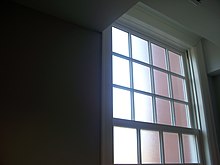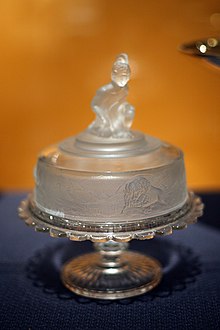



Frosted glass is produced by the sandblasting or acid etching of clear sheet glass. This creates a pitted surface on one side of the glass pane and has the effect of rendering the glass translucent by scattering the light which passes through, thus blurring images while still transmitting light. It has 10–20% opacity.[citation needed]
Applications:
The frosted glass effect can also be achieved by the application of vinyl film, used as a sort of stencil on the glass surface. "Photo-resist", or photo-resistant film is also available, which can be produced to mask off the area surrounding a decorative design, or logo on the glass surface. A similar effect may also be accomplished with the use of canned frosted glass sprays.
As a rule, frosted glass is not suitable for recycling through glass bins.[1] This is because the etchants used to produce some frosted glass can leave chemical residue, which can interfere with the recycling process and spoil a whole batch. Frosted glass that was not acid-etched but rather produced by sandblasting is recyclable in principle, however, since it can be hard to tell how a given piece of frosted glass was manufactured, most recyclers will reject frosted glass absent a contract with specific assurances.